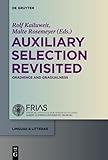Auxiliary Selection Revisited : Gradience and Gradualness / ed. by Rolf Kailuweit, Malte Rosemeyer.
Material type: TextSeries: linguae & litterae : Publications of the School of Language and Literature Freiburg Institute for Advanced Studies ; 44Publisher: Berlin ; Boston : De Gruyter, [2015]Copyright date: ©2015Description: 1 online resource (364 p.)Content type:
TextSeries: linguae & litterae : Publications of the School of Language and Literature Freiburg Institute for Advanced Studies ; 44Publisher: Berlin ; Boston : De Gruyter, [2015]Copyright date: ©2015Description: 1 online resource (364 p.)Content type: - 9783110347371
- 9783110386431
- 9783110348866
- 415/.6 23
- P120.V37 A99 2015
- P120.V37 A99 2015
- online - DeGruyter
- Issued also in print.
| Item type | Current library | Call number | URL | Status | Notes | Barcode | |
|---|---|---|---|---|---|---|---|
 eBook
eBook
|
Biblioteca "Angelicum" Pont. Univ. S.Tommaso d'Aquino Nuvola online | online - DeGruyter (Browse shelf(Opens below)) | Online access | Not for loan (Accesso limitato) | Accesso per gli utenti autorizzati / Access for authorized users | (dgr)9783110348866 |
Browsing Biblioteca "Angelicum" Pont. Univ. S.Tommaso d'Aquino shelves, Shelving location: Nuvola online Close shelf browser (Hides shelf browser)

|

|

|

|

|

|

|
||
| online - DeGruyter Die Athener und ihre Gräber (1000-300 v. Chr.) / | online - DeGruyter Erzählte Selbstrepräsentation im modernen Roman / | online - DeGruyter Hermann Paul's 'Principles of Language History' Revisited : Translations and Reflections / | online - DeGruyter Auxiliary Selection Revisited : Gradience and Gradualness / | online - DeGruyter Space and Time : A Priori and A Posteriori Studies / | online - DeGruyter Zugänge zur Rechtssemantik : Interdisziplinäre Ansätze im Zeitalter der Mediatisierung / | online - DeGruyter Complexity, Isolation, and Variation / |
Frontmatter -- Contents -- Introduction -- Section 1: (Limits of) Semantic and syntactic gradience -- The cognitive complexity of auxiliary selection: from processing to grammaticality judgements -- Perfective auxiliation with reflexives in Medieval Romance: syntactic vs. semantic gradients -- Auxiliary selection with intransitive and reflexive verbs: the limits of gradience and scalarity, followed by a proposal -- Section 2: Between constructional variation and auxiliary selection -- On the irrealis effect on auxiliary selection -- The HAVE/BE alternation in Scandinavian – perfects, resultatives and unaccusative structure -- A constructional approach to auxiliary selection: evidence from existential constructions -- Periphrasis as a precursor of analytic inflection: auxiliation in the (pre-)history of German -- Section 3: Mechanisms of Gradual Change: BE > HAVE and HAVE > BE -- BE or HAVE in Contemporary Standard French – residua of semantic motivation -- The auxiliary selection of French monter ‘move upward’ from the 16th to the 20th century -- Entrenchment and discourse traditions in Spanish auxiliary selection -- Auxiliary selection in closely related languages: the case of German and Dutch -- General index -- Language index
restricted access online access with authorization star
http://purl.org/coar/access_right/c_16ec
A central debate about the description of auxiliary selection concerns the regularity of auxiliary selection from a typological perspective. Thus, studies of auxiliary selection have both stressed the fact that certain recurrent parameters are highly relevant to the description of auxiliary selection, whereas other studies demonstrate significant differences in auxiliary selection systems.By integrating the synchronic and diachronic levels of linguistic description, the papers in the present volume work towards a framework that explains these contradictory findings. They discuss the role of semantic and syntactic constraints in gradient auxiliary selection, address the question of paradigmaticity of the have-be alternation, and shed light on the mechanisms of the gradual historical change from be- to have-selection.The volume thus puts forth a row of innovative theoretical and empirical findings from a wide range of typologically diverse European languages that substantially broaden our knowledge about the mechanisms of auxiliary selection systems.
Issued also in print.
Mode of access: Internet via World Wide Web.
In English.
Description based on online resource; title from PDF title page (publisher's Web site, viewed 25. Jun 2024)


